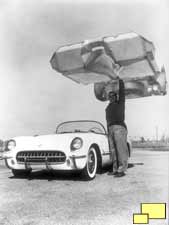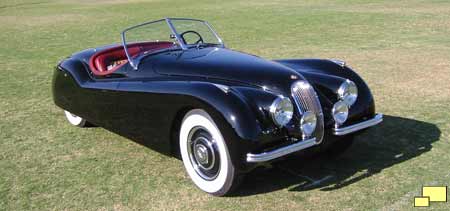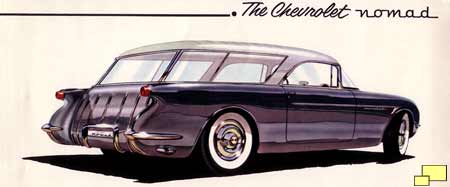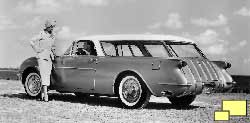Corvette: Year by Year
1953 1954 1955 1956 1957 1958 1959 1960 1961 1962 1963 19641965 1966 1967 1968 1969 1970 1971 1972 1973 1974 1975 1976
1977 1978 1979 1980 1981 1982 1983 1984 1985 1986 1987 1988
1989 1990 1991 1992 1993 1994 1995 1996 1997 1998 1999 2000
2001 2002 2003 2004 2005 2006 2007 2008 2009 2010 2011 2012
2013 2014 2015 2016 2017 2018 2019 2020 2021 2022 2023 2024
Something different began to appear on American roads: sports cars. GIs that served in Europe discovered a real affection for MGs and many other small two seaters and brought them home with them. All sorts of sports car events, from rallies to hard core races, showed a sudden burst of popularity.
The lead instigator in the birth of the Corvette was Harley Earl, the head of GM's Art and Color studio. He was a sports car aficionado, and an admirer of the Jaguar XK-120.
Harley Earl (left) was the head of GM design from 1927 to 1958 and inspired the two seat American sports car we know as the Corvette. He was a big fan of the Jaguar XK-120 (right). Note the basic design of the Jaguar: huge long hood, minimal two seat passenger area and a short rear deck. This same philosophy would be the basis for the Corvette for more than 50 years. In the beginning, all Corvettes featured fiberglass bodies. The material was relatively new in 1953 when the first Corvettes appeared. It was renowned for its light weight - as per the photo to the right - and can be thought of as the carbon fiber of the 1950s. At that time only a few cars available to the public featured fiberglass bodies but the material was popular with design studios as it was a low cost method to quickly create interesting body styles.
In the beginning, all Corvettes featured fiberglass bodies. The material was relatively new in 1953 when the first Corvettes appeared. It was renowned for its light weight - as per the photo to the right - and can be thought of as the carbon fiber of the 1950s. At that time only a few cars available to the public featured fiberglass bodies but the material was popular with design studios as it was a low cost method to quickly create interesting body styles.
As the technology advanced, more modern composite materials were used and fiberglass, as used in the first Corvettes, was phased out.
Corvette started life in fiberglass form mostly out of necessity. Only 300 were made in the first production model year and fiberglass is well suited to low volume production since creating the tooling to stamp out steel panels is expensive. Labor and supply problems with steel also contributed to the decision to build a fiberglass body for the Corvette. Years later Corvette production would climb to numbers that favored steel production which was more efficient as steel bodies did not need time to cure inside of molds. Tradition, always an important factor in the Corvette story, dictated that the distinctive fiberglass body material would remain in use.
The use of fiberglass as a body material brings up another sometimes controversial Corvette subject: build quality. Through the years it has varied, being poor in the beginning and improving as customers demanded better paint jobs and fit / finish. Early Corvettes had large panel fit problems; you can even see this in the photographs, so up close and in person they are very obvious. Another problem is panel waviness. This can present a dilemma to anyone who is restoring a Corvette. Do you keep the panel as it was delivered from the factory or should it be smoothed out?
Fiberglass played another roll in the Corvette story. Certain shapes and styling themes can favor steel or fiberglass body construction; it is part of the nature of the characteristics of both materials. This explains the many distinctive styling advantages the Corvette has enjoyed over the years.
Add Comment
This policy contains information about your privacy. By posting, you are declaring that you understand this policy:
- Your name, rating, website address, town, country, state and comment will be publicly displayed if entered.
- Aside from the data entered into these form fields, other stored data about your comment will include:
- Your IP address (not displayed)
- The time/date of your submission (displayed)
- Your email address will not be shared. It is collected for only two reasons:
- Administrative purposes, should a need to contact you arise.
- To inform you of new comments, should you subscribe to receive notifications.
- A cookie may be set on your computer. This is used to remember your inputs. It will expire by itself.
This policy is subject to change at any time and without notice.
These terms and conditions contain rules about posting comments. By submitting a comment, you are declaring that you agree with these rules:
- Although the administrator will attempt to moderate comments, it is impossible for every comment to have been moderated at any given time.
- You acknowledge that all comments express the views and opinions of the original author and not those of the administrator.
- You agree not to post any material which is knowingly false, obscene, hateful, threatening, harassing or invasive of a person's privacy.
- The administrator has the right to edit, move or remove any comment for any reason and without notice.
Failure to comply with these rules may result in being banned from submitting further comments.
These terms and conditions are subject to change at any time and without notice.











Comments (2)
Being the second son of my father I'm VERY disappointed by the "Cover-up" about this very big detail being COMPLETELY left out of the cars REAL history!!!